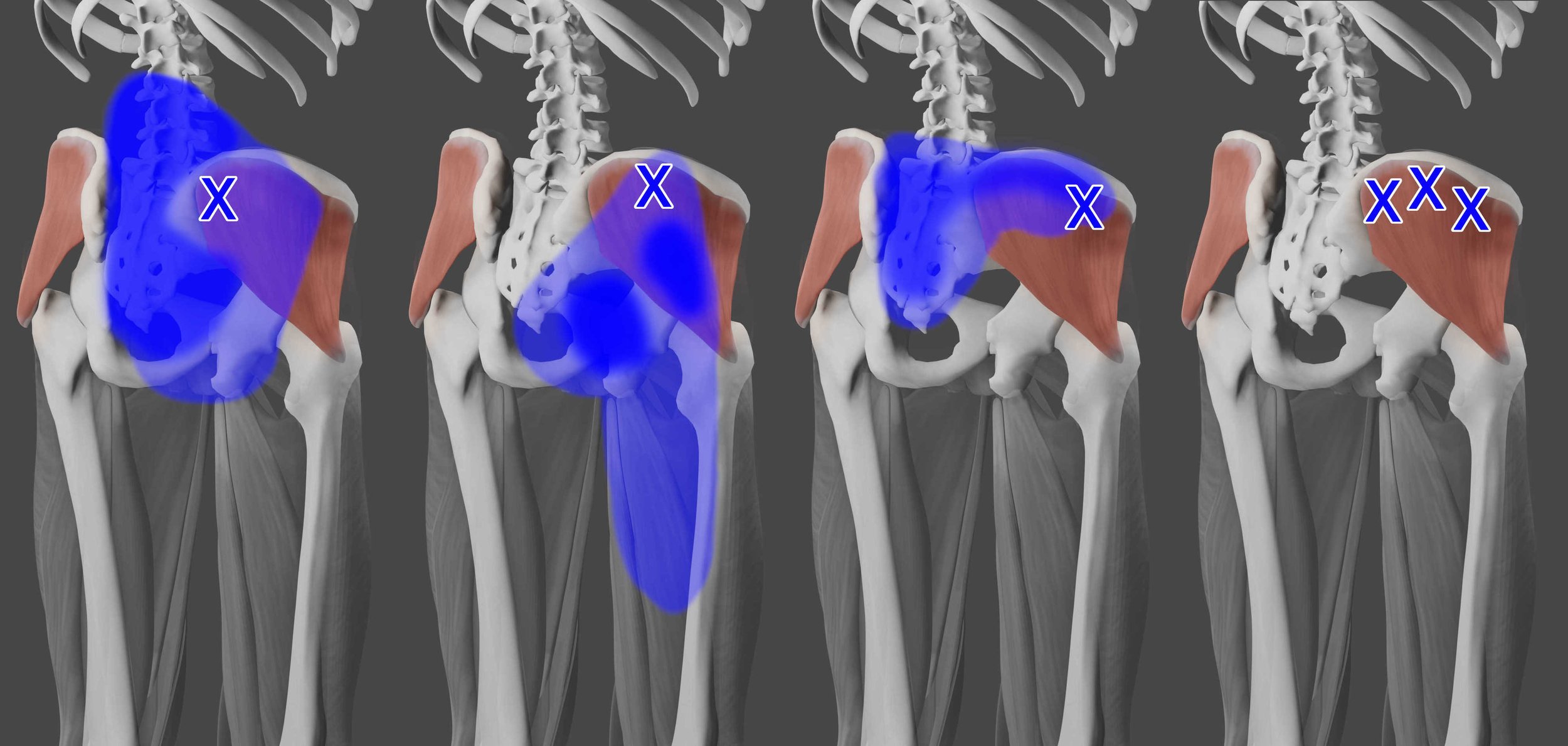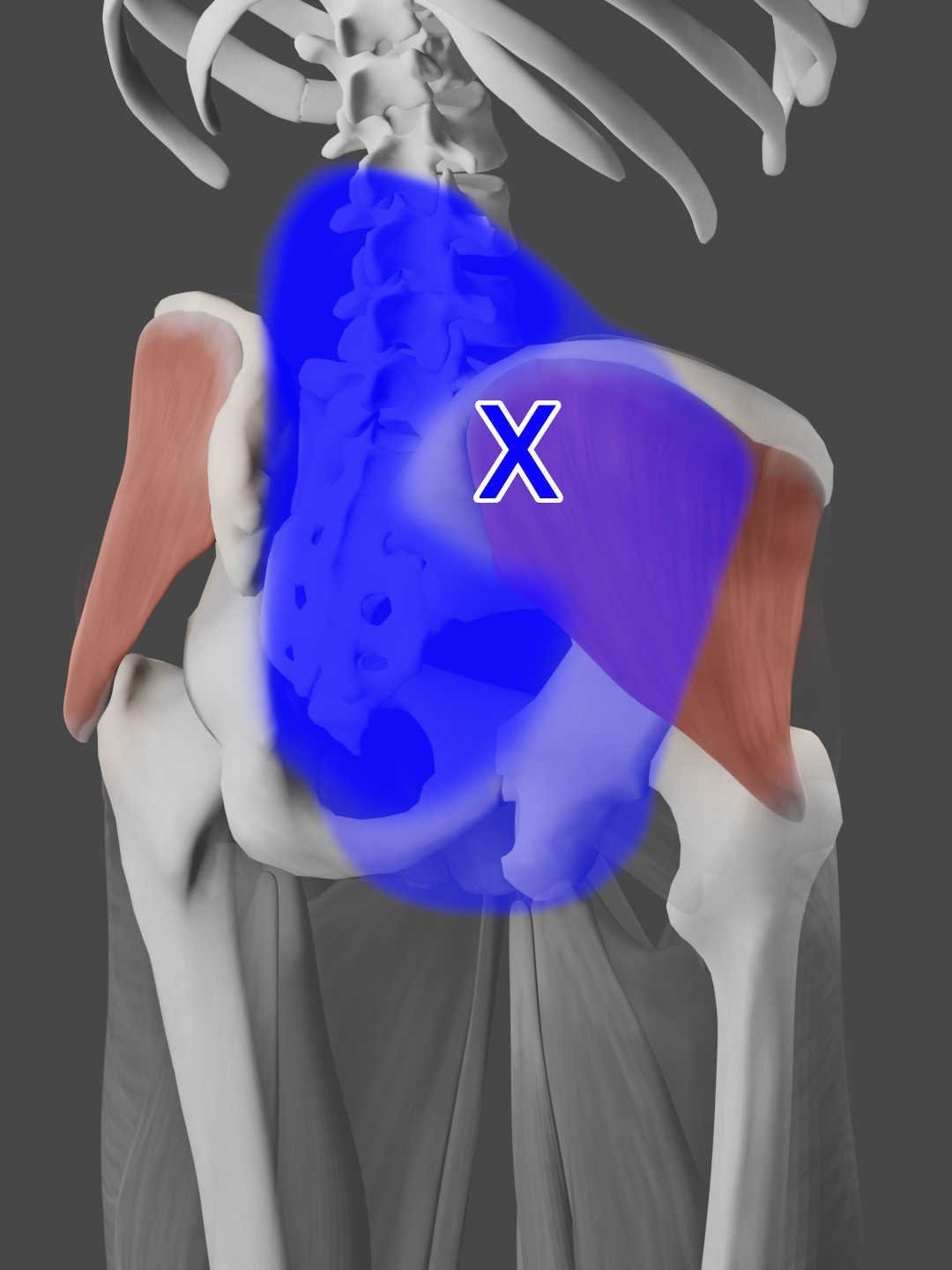Acupuncture for Gluteus Medius Pain
What is the gluteus medius?
The gluteus medius muscle is one of the three muscles that make up the buttocks. It is located on the outer surface of the hip and attaches to the outer surface of the thigh bone (femur) and the outer surface of the pelvis (ilium). It plays an important role in stability and movement.
The main function of the gluteus medius muscle is to stabilize the hip and pelvis during weight-bearing activities such as walking, running, and stair climbing. It also helps to abduct the hip (move it away from the midline of the body), and rotate the hip internally.
This article will explore the causes and symptoms of gluteus medius pain, as well as the role of trigger points in the development of pain and discomfort.
Read more to learn about gluteus medius trigger points and how acupuncture and dry needling can help hip and back pain naturally.
Causes of Gluteus Medius Pain
Pain in the gluteus medius can be caused by a variety of factors, including injury, overuse, and trigger points. Overuse injuries, such as running or hiking, can lead to inflammation and pain in the muscle. Trigger points, or hyperirritable knots of muscle fibers that cause pain, can also develop in response to injury, overuse, or stress. In some cases, gluteus medius pain may also be caused by underlying conditions, such as hip osteoarthritis or sciatica.
Weakness in the gluteus medius muscle can lead to a condition called hip hike, where the pelvis drops on one side when standing on one leg. It can also lead to pain in the hip, knee or lower back and may lead to compensation patterns in the lumbar spine and pelvis.
One study found that releasing gluteus medius trigger points helped reduce knee pain due to patellofemoral pain syndrome (PFPS).
Gluteus medius trigger points are commonly implicated in cases of low back pain, sacroiliac joint (SI joint) pain, and buttock pain. This muscle affects a wide range of people including high level athletes and runners, and more sedentary people that spend long periods of time sitting. It is commonly the muscle affected when someone has a “pulled butt muscle.”
Treatment for Gluteus Medius Pain
Treatment for weakness or pain in the gluteus medius muscle may include exercises to strengthen the muscle, such as side leg raises, squats, lunges, and glute bridges. Acupuncture, dry needling, physical therapy, and other modalities may also be used to reduce pain and improve muscle function. It's important to consult with a qualified practitioner such as an acupuncturist, physical therapist, chiropractor, or sports medicine doctor to determine the cause of the pain or weakness and develop an appropriate treatment plan.
It's also important to maintain good form during exercises and activities to prevent overuse or injury to the gluteus medius muscle, and to use good ergonomic practices when using computers or other electronic devices to help prevent tension and pain in the gluteus medius muscle.
Origin and insertion of the gluteus medius muscle
The gluteus medius muscle originates just below the iliac crest, along the glueteal surface of the ilium (the uppermost part of the hip bone). It inserts at the lateral aspect of the greater trochanter.
It is located deep to the gluteus maximus muscle and superficial to the gluteus minimus muscle.
Just based on the origin and insertion of this muscle, we can see then when it’s tight or shortened, it can pull the top of the hip and the greater trochanter closer together which can tilt the hip, pull on the low back and hip flexors, and tug on the greater trochanter. When there are gluteus medius trigger points, it is common to see pain in one or more of these areas.
Actions of the Gluteus Medius Muscle
Abduct the hip (all fibers)
Flex and medially rotate the hip (anterior fibers)
Extend and laterally rotate the hip (posterior fibers)
The gluteus medius is an important postural muscle and it is heavily involved in walking/running and single leg exercises because it is involved in almost all of the actions related to the hip. It is a major hip stabilization muscle during any single leg stance. It prevents the opposite side of the hip from dropping during movement and provides basic stability for the pelvis during movement and exercise. Tightness or weakness in the muscle can be linked to numerous lower body injuries as well as issues with movement and the gait cycle.
When the gluteus medius is weak or tight it can affect other muscles around it which need to compensate and become overactive. One 2017 study found a relationship between the gluteus medius, the tensor fascia latae (a hip flexor muscle), and the quadratus lumborum (a low back muscle), which makes sense since those other muscles attach at other parts of the pelvis and would need to adjust if there are issues with the gluteus medius.
Some injuries that weakness or tightness of the gluteus medius muscle include iliotibial band (IT band) syndrome, patellofemoral pain syndrome (PFPS), knee issues including anterior cruciate ligament (ACL) injuries, and ankle injuries.
Gluteus Medius Trigger Points
Travell & Simons refer to the gluteus medius muscle as the “Lumbago Muscle” which refers to its propensity to be involved in many cases of low back pain. There are three main trigger point areas in the muscle that generally refer pain to the low back, across the ilium, to the sacrum, and the lateral/posteior buttock. Gluteus minimus trigger points are a common cause of low back pain, and they can also cause sacroiliac pain and lumbar pain.
Trigger points in the gluteus medius may result in secondary or “satellite” trigger points forming in the piriformis, gluteus minimus, or gluteus maximus. Glute medius trigger points may also be secondary trigger points due to quadratus lumborum trigger points.
Pain Associated with Gluteus Medius Trigger Points
Buttock Pain
Iliosacral Pain
Lumbar Pain
Signs and Symptoms of Gluteus Medius Trigger points
Pain when walking, especially if there is an uncorrected Morton foot structure
Difficulty sleeping on the affected side
Sitting in a slumped position may activate these trigger points
Can be triggered by sudden falls, sports injuries, running, and weight bearing on one leg for an extended period
Sitting for long periods of time, sitting with legs crossed, side sleeping without a pillow between the knees, putting pants on while standing on one leg, and sitting on a thick wallet can also activate or worse gluteus medius trigger points
Causes of Gluteus Medius Trigger Points
Sudden falls or sports injuries
Running, tennis, soccer, hockey, skiing, and other sports
Aerobics
Long walks on soft sandy beach
Weight bearing on one leg for a long time
Medication injections into muscle
Leg length discrepancy
Morton foot structure
Gluteus Medius Trigger Point Locations
Gluteus Medius Trigger Point #1
This is the most medial and refers pain primarily to the low back, iliac crest, SI joint, and sacrum.
Gluteus Medius Trigger Point #2
This trigger point is located more lateral and cephalic (towards the head) and refers pain lower into the buttock and the the upper thigh both laterally and posteriorly.
Gluteus Medius Trigger Point #3
This one is the most anterior and refers pain over the sacrum, across the iliac crest, and into the lower lumbar area.
How can acupuncture and dry needling relieve gluteus medius trigger points?
Acupuncture and dry needling are two myofascial release therapies that can be used to release trigger points in the gluteus medius muscle.
Acupuncture involves the insertion of fine, sterile needles into specific points on the body to relieve pain and promote healing. In the case of gluteus medius trigger points, the acupuncture needles can be inserted directly into the muscle to help relieve tension, release trigger points, and improve circulation. The insertion of the needles can also stimulate the release of natural pain-relieving chemicals in the body, reducing discomfort and promoting healing.
Dry needling is a more specific needling technique focused on the release of trigger points in the muscle, by identifying the taut bands of muscle that create the pain referral pattern and eliciting a twitch response to relax the muscle to restore function and reduce pain.
A 2022 study showed that dry needling of gluteus medius trigger points offers effective pain relief for low back pain (non-specific low back pain) measured by pain intensity, quality of life, and pressure pain threshold in patients both 48 hours and 1 week after treatment. The study also found that dry needling outperformed ischemic compression, another treatment technique for trigger points in both short term and medium term measures.
To schedule an appointment please
call or text us at (917) 830-4440
or contact us below
Sources:
Travell, J. G., Simons, D. G. (1993). Myofascial pain and dysfunction: The trigger point manual (Vol. 2). London: Lippincott Williams & Wilkins.
Biel, A., & Dorn, R. (2010). Trail guide to the body: A hands-on guide to locating muscles, bones and more. Boulder, CO: Books of Dicovery.
Janda, Vladimír. “Muscle Function Testing.” (1983).
Karamiani F, Mostamand J, Rahimi A, Nasirian M. The Effect of Gluteus Medius Dry Needling on Pain and Physical Function of Non-athlete women with Unilateral Patellofemoral Pain Syndrome: A Double-Blind Randomized Clinical Trial. J Bodyw Mov Ther. 2022 Apr;30:23-29. doi: 10.1016/j.jbmt.2022.02.005. Epub 2022 Feb 9. PMID: 35500976.
Kim H, Lee H, Jung H. Difference of Muscle Activity by Pelvic Tilt in Side-Lying Hip Abduction. KSPM 2017;12:59-66. https://doi.org/10.13066/kspm.2017.12.3.59
Presswood, Laura1; Cronin, John PhD2,3; Keogh, Justin W L PhD3; Whatman, Chris MAppSc3. Gluteus Medius: Applied Anatomy, Dysfunction, Assessment, and Progressive Strengthening. Strength and Conditioning Journal 30(5):p 41-53, October 2008. | DOI: 10.1519/SSC.0b013e318187f19a
Álvarez, S. D., Velázquez Saornil, J., Sánchez Milá, Z., Jaén Crespo, G., Campón Chekroun, A., Barragán Casas, J. M., Frutos Llanes, R., & Rodríguez Sanz, D. (2022). Effectiveness of Dry Needling and Ischemic Trigger Point Compression in the Gluteus Medius in Patients with Non-Specific Low Back Pain: A Randomized Short-Term Clinical Trial. International journal of environmental research and public health, 19(19), 12468. https://doi.org/10.3390/ijerph191912468
Disclaimer: This web site is intended for educational and informational purposes only. Reading this website does not constitute providing medical advice or any professional services. This information should not be used for diagnosing or treating any health issue or disease. Those seeking medical advice should consult with a licensed physician. Seek the advice of a medical doctor or other qualified health professional for any medical condition. If you think you have a medical emergency, call 911 or go to the emergency room. No acupuncturist-patient relationship is created by reading this website or using the information. Morningside Acupuncture PLLC and its employees and contributors do not make any express or implied representations with respect to the information on this site or its use.







